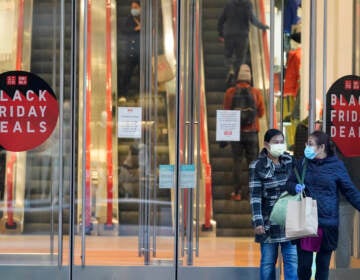The marathon known as ‘Black Friday’ actually has its roots in Philadelphia
-
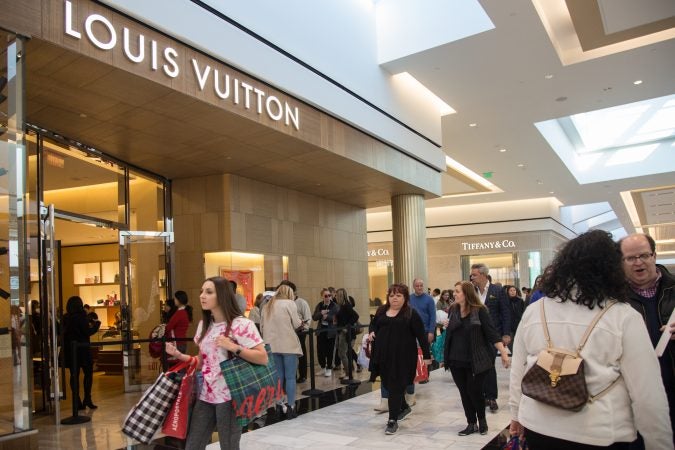
As shoppers make their way to stores others wait in lines outside the stores for their turn to shop on Black Friday at the King of Prussia Mall in Pennsylvania November 23rd 2018. (Emily Cohen for WHYY)
-
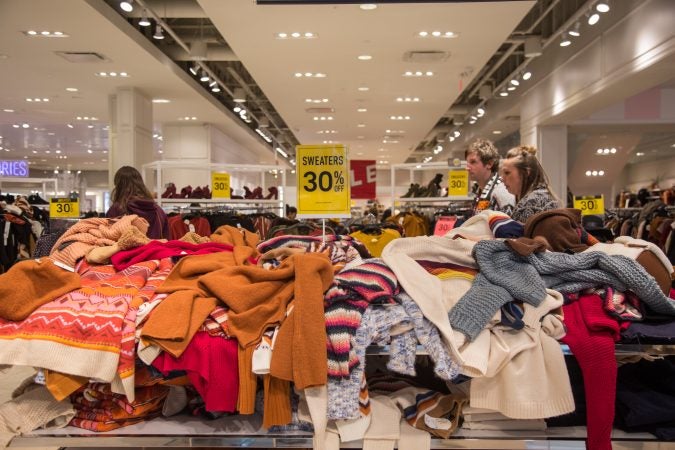
Sweaters are strewn about at Forever 21 on Black Friday at the King of Prussia Mall. (Emily Cohen for WHYY)
-

Shoppers take a break from shopping on Black Friday at the King of Prussia Mall in Pennsylvania November 23rd 2018. (Emily Cohen for WHYY)
-
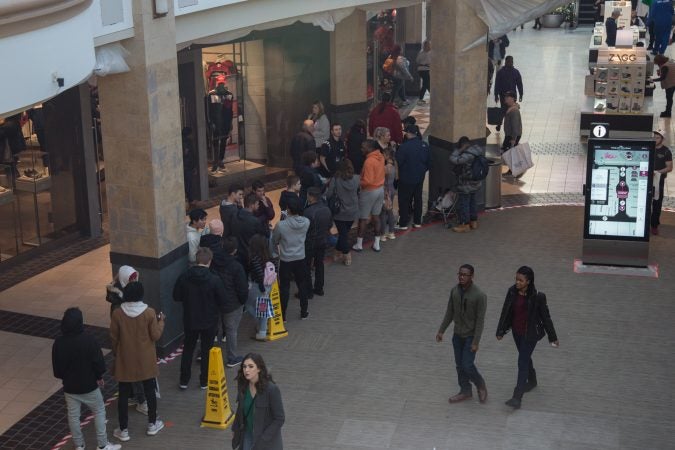
Shoppers line up for thir oppurtunity to shop at ADIDAS on Black Friday at the King of Prussia Mall in Pennsylvania November 23rd 2018. (Emily Cohen for WHYY)
-
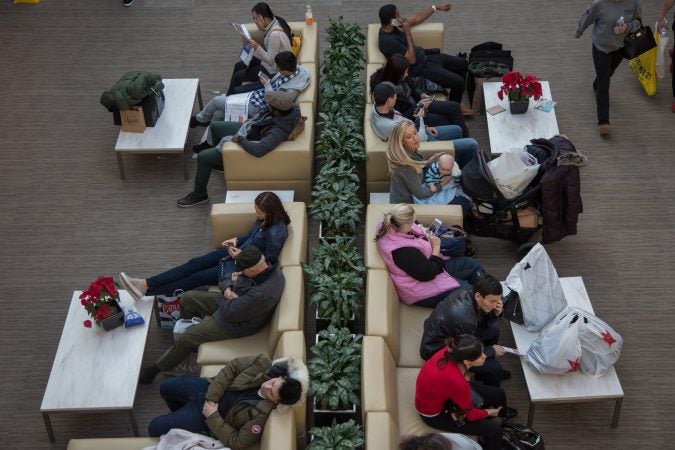
Shoppers take a break from the crowds and shopping on Black Friday at the King of Prussia Mall in Pennsylvania November 23rd 2018. (Emily Cohen for WHYY)
-
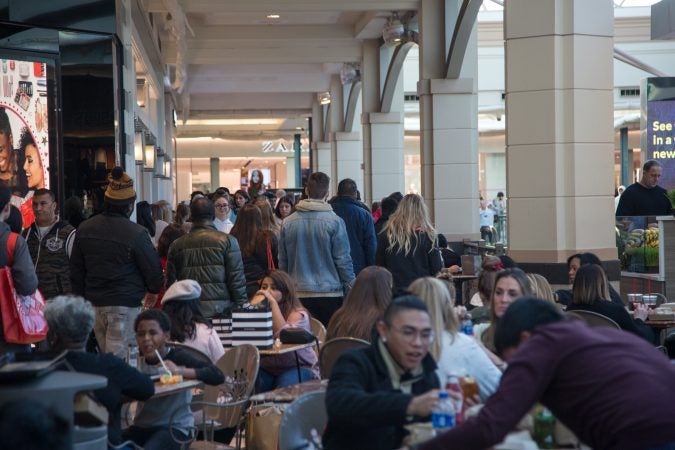
Shoppers pass around the crowds of the food court as others take a lunch break on Black Friday at the King of Prussia Mall in Pennsylvania November 23rd 2018. (Emily Cohen for WHYY)
-

Shoppers pass through the crowds on Black Friday at the King of Prussia Mall in Pennsylvania November 23rd 2018. (Emily Cohen for WHYY)
Updated 1:07 p.m.
The Thanksgiving turkey barely had a chance to digest before the “opportunity” to find those doorbuster sales had begun.
With the Black Friday sales beginning on Thanksgiving, it’s become more of a marathon than a sprint for those seeking bargains in brick and mortar stores.
Even though for the most part the bargains can be found online, Amanda Massing came to the Deptford Mall in the pre-dawn hours to shop.
“Oh it’s just a tradition we do every year,” Massing said.
Howard Veit was a man on a mission, stopping at only one store and in and out in minutes.
“I had to get something from Pandora and I’m done for the day,” Veit said. “I wanted to get it over early.”
At the other extreme was one person with an ironic name, Kylee Cyber. She could have shopped online, but decided it was better to spend all night shopping.
“JC Penney’s Walmart Target, Dicks, everywhere,” Cyber said. She estimates she saved $200 at one store alone.
Despite temperatures in the teens, shoppers like Sheila Brantley took to the stores to find those great deals.
“You go online [and] it takes the fun out of coming out watching everyone trying to rush and get their sizes,” Brantley said.
“You want to come out here, you want to see people and everything like that.”
Some stores opened for a few hours Thursday evening and reopened this morning with plenty of people lined out the door.
Black Friday history rooted in Philadelphia
Before Black Friday became synonymous with one of the most successful days for businesses every year, it had a negative connotation.
According to History.com, Philadelphia Police used the term in the 1960s to describe the car and foot traffic caused by post-Thanksgiving Day shoppers — and as a way to make shoppers in the city view the shopping frenzy as a problem. Adding to the traffic gridlock of that time was the Army-Navy game. Traditionally, it would take place the weekend after Thanksgiving. Crowds would arrive on Friday.
Bonnie Taylor Blake, a research analyst from the University of North Carolina at Chapel Hill, discovered a press release from 1961 that details how the City of Philadelphia then attempted to spin Black Friday with a positive approach, decidedly rebranding the shopping weekend after Thanksgiving as “Big Friday” and “Big Saturday.”
We can see that didn’t stick.
In an Associated Press article from 1975, a Gimbels sales manager discussed seeing police officers attempting to direct and control a crowd of jaywalkers in Center City.
“That’s why the bus drivers and cab drivers call today Black Friday,” she said. “They think in terms of the headaches it gives them.”
By the 1980s, retail businesses had come to accept the insanity of Black Friday and took on a different positive outlook for the shopping day — this time referring to businesses being “in the black,” or turning a profit as the holiday shopping season “officially” begins.
Shoppers nationwide ditch their computers, flock to stores
It would have been easier to turn on their computers over plates of leftover turkey and take advantage of the Black Friday deals most retailers now offer online.
But across the country, thousands of shoppers woke up before dawn the day after Thanksgiving to take part in this most famous ritual of American consumerism.
Shoppers lined up outside the Mall of America in Bloomington, Minnesota by 4 a.m., and the crowd had grown to 3,000 people by the time doors opened at 5 a.m. In Ohio, a group of women was so determined, they booked a hotel room Thursday night to be closer to the stores. In New York City, one woman went straight from a dance club to a department store in the middle of the night.
Many shoppers said Black Friday shopping is as much about the spectacle as it is about doorbuster deals.
Kati Anderson said she stopped at Cumberland Mall in Atlanta Friday morning for discounted clothes as well as “the people watching.” Her friend, Katie Nasworthy, said she went to the mall instead of shopping online because she likes to see the Christmas decorations.
“It doesn’t really feel like Christmas until now,” said Kim Bryant, who considers the day the official kickoff of the holiday shopping season, though retailers have been offering deals for weeks. Bryant was shopping at a mall in suburban Denver with her daughter and her daughter’s friend, who lined up at 5:40 a.m., then sprinted inside when the doors opened at 6 a.m.
“We felt the need to run in because everyone else was running,” Bryant’s daughter, Kelly, said.
The holiday shopping season presents a big test for a U.S. economy, whose overall growth so far this year has relied on a burst of consumer spending. Americans upped their spending during the first half of 2018 at the strongest pace in four years, yet retail sales gains have tapered off recently and the pace of homebuying has fallen outright. The sales totals over the next month will be a good indicator as to whether consumers simply paused to catch their breath or if they feel slightly less optimistic about the economy in 2019.
The National Retail Federation, the nation’s largest retail trade group, is expecting holiday retail sales in November and December — excluding automobiles, gasoline and restaurants — to increase as much as 4.8 percent over 2017 for a total of $720.89 billion. The sales growth marks a slowdown from last year’s 5.3 percent, which was the largest gain since 2010. But the figure is still healthy.
The retail economy is also tilting steeply toward online shopping. Over the past 12 months, purchases at non-store retailers such as Amazon have jumped 12.1 percent. Meanwhile, sales at traditional department stores have slumped 0.3 percent.
“There’s major deals online so it’s hard to make a major effort to come to the store,” said Laura Duncan, a 39-year-old preschool teacher and mother of three from Costa Mesa, California. She was drawn to the mall Friday morning for the deals, and for the quiet of shopping without her still-sleeping kids.
Adobe Analytics, which tracks online retail spending, reported Thursday that Thanksgiving should reach a record $3.7 billion in online retail sales, up 29 percent from the same year-ago period.
Black Friday has morphed from a single day when people got up early to score door busters into a whole month of deals. Many major stores, including Walmart, Best Buy and Macy’s, start their blockbuster deals on Thanksgiving evening, which has thinned out the Friday crowds.
But some families stick by their Black Friday traditions.
“We boycotted Thursday shopping; that’s the day for family. But the experience on Friday is just for fun,” said Michelle Wise, shopping at Park Meadows Mall in Denver with her daughters, 16-year-old Ashleigh and 14-year-old Avery. They didn’t have a specific list of must-get items this year; they just enjoy the time together.
Retailers have also been introducing new technology to make it easier to shop inside their stores. Walmart has a new digital map on its mobile app so shoppers can find an item’s exact location in the store. The Kohl’s app lets customers take photos of products anywhere and find similar items at the department store. And customers, frustrated with long checkout lines, can check out at Walmart and other stores with a salesperson in store aisles.
Target reported that shoppers bought big-ticket items like TVs, iPads, and Apple Watches. Among the most popular toy deals were Lego, L.O.L. Surprise from MGA Entertainment and Mattel’s Barbie. It said gamers picked up video game consoles like Nintendo Switch, PlayStation 4 and the Xbox One.
Others reported stumbling onto more obscure savings. At a Cincinnati mall, Bethany Carrington scored a $29 all-in-one trimmer for her husband’s nose hair needs and, for $17, “the biggest Mr. Potato Head I’ve ever seen.”
At the same mall, Rhonda Ross and Cyndi Jenkins booked a hotel room for Thursday night to maximize their shopping experience. They knew they wanted to buy the Nintendo Switch for their 11-year-old sons, but otherwise just planned to look around and spend time together. Every year, they leave the kids with their husbands and come out to shop.
“We’re not run-over-people, die-hard shoppers,” said Jenkins, a nurse from Lucasville, Ohio.
By mid-day Friday, there had not been widespread reports of the deal-inspired chaos that has become central to Black Friday lore — fist fights over discounted televisions or stampedes toward coveted sale items.
Two men at an Alabama mall got into a fight, and one of the men opened fire, shooting the other man and a 12-year-old bystander, both of whom were taken to the hospital with injuries. Police shot and killed the gunman. Authorities have not said whether the incident was related to Black Friday shopping or if it stemmed from an unrelated dispute.
“It’s really not that crazy this morning,” said Clif Norwine, as he looked out over the Galleria Dallas mall from an upstairs balcony. Norwine says he comes out to Black Friday in part for the sales, but also for the family tradition and the people watching. Shoppers below drifted peacefully, set to a soundtrack of holiday music.
____
Associated Press writers Jeff Martin in Atlanta, Ryan Tarinelli in Dallas, Katie Foody in Denver, Angie Wang in Cincinnati, Amy Taxin from Costa Mesa, California, and Claire Galofaro in Louisville, Kentucky, also contributed to this report.
WHYY is your source for fact-based, in-depth journalism and information. As a nonprofit organization, we rely on financial support from readers like you. Please give today.




